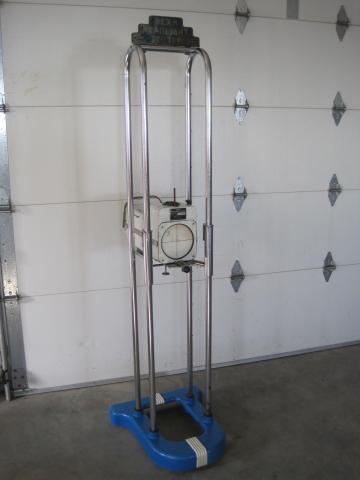Light Up The Night.
Every so often someone posts to the SDC Forum asking about headlight aiming, so I thought I'd document some answers and useful links here.
The high-tech, pay-someone-else-to-do-it method is to find a shop with a beamsetter. It used to be a lot easier to find these - remember the yellow Bear Headlight Alignment signs with the little laughing bear (that the Grateful Dead later copped) outside gas stations?
These items basically consisted of a unidirectional photocell that measured the candlepower of the light emitted by your headlamps. You pulled up square to the unit and adjusted the lamp until the focus of the beam produced the highest reading on the CP meter. (More about Bear Beamsetters here, if you're interested.)
Needless to say, these are rare birds in this day of sealed headlamp assemblies and halogen cartridge bulbs. So how do you aim an old Studebaker's lamps?
Daniel Stern in a guy who lives and breathes automotive lighting. His website has just about everything you'd want to know about bulbs, circuitry, output, regulations and more car lighting esoterica than you can shake a stick at. He has a wonderful, plain-language explanation of how to aim the bulbs on nearly any car - all you really need is a flat surface, about 40 feet of work space, a vertical wall and some painter's tape. Read it here: www.danielsternlighting.com/tech/aim/aim.html .
And while you're at it, maybe think about upgrading the headlamp circuitry on that old car. Another frequent question on the Forum is "Why do my headlights keep blinking on and off at night?" Generally, it's due to one of two things:
The solution is to install a modern headlamp relay circuit. This takes the amps out of your dashboard and routes them directly from the generator/alternator to the bulbs, instead of taking the long way 'round through the Inland Empire (SoCal residents get the joke).
Daniel Stern also has a great article on how to do this, natch: read www.danielsternlighting.com/tech/relays/relays.html for the whole skinny.
Because there's nothing worse than being out for a nice cruise on a warm summer night... then having to feel your way home against the curb because your eyes suddenly went dark.
The high-tech, pay-someone-else-to-do-it method is to find a shop with a beamsetter. It used to be a lot easier to find these - remember the yellow Bear Headlight Alignment signs with the little laughing bear (that the Grateful Dead later copped) outside gas stations?
These items basically consisted of a unidirectional photocell that measured the candlepower of the light emitted by your headlamps. You pulled up square to the unit and adjusted the lamp until the focus of the beam produced the highest reading on the CP meter. (More about Bear Beamsetters here, if you're interested.)
Needless to say, these are rare birds in this day of sealed headlamp assemblies and halogen cartridge bulbs. So how do you aim an old Studebaker's lamps?
Daniel Stern in a guy who lives and breathes automotive lighting. His website has just about everything you'd want to know about bulbs, circuitry, output, regulations and more car lighting esoterica than you can shake a stick at. He has a wonderful, plain-language explanation of how to aim the bulbs on nearly any car - all you really need is a flat surface, about 40 feet of work space, a vertical wall and some painter's tape. Read it here: www.danielsternlighting.com/tech/aim/aim.html .
And while you're at it, maybe think about upgrading the headlamp circuitry on that old car. Another frequent question on the Forum is "Why do my headlights keep blinking on and off at night?" Generally, it's due to one of two things:
- That little booger on the left, there - a headlamp circuit breaker that's gotten old and weak, and is kicking off when the juice is applied, then back on as it cools down.
- The breaker is fine, but your wiring, switches and connections are old, and resistance in the headlamp circuit is so high that the breaker is doing its job, kicking off to prevent your wiring harness from turning into a mass of carbonized copper with melted plastic dripping off it.
The solution is to install a modern headlamp relay circuit. This takes the amps out of your dashboard and routes them directly from the generator/alternator to the bulbs, instead of taking the long way 'round through the Inland Empire (SoCal residents get the joke).
Daniel Stern also has a great article on how to do this, natch: read www.danielsternlighting.com/tech/relays/relays.html for the whole skinny.
Because there's nothing worse than being out for a nice cruise on a warm summer night... then having to feel your way home against the curb because your eyes suddenly went dark.
Labels: Electrical, headlights, lighting, Miscellaneous



